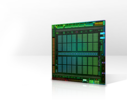Intel UHD Graphics Xe 750 32EUs (Rocket Lake) vs NVIDIA GeForce GTX 980 Ti
Intel UHD Graphics Xe 750 32EUs (Rocket Lake)
► remove from comparison
Die Intel UHD Graphics Xe 750 (Rocket-Lake mit 32 EUs) ist eine Prozessorgrafikkarte, welche im März 2021 vorgestellt wurde. Sie basiert auf die neue Xe Architektur (Gen12, wie auch Tiger Lake) und bietet eine deutlich höhere Leistung als die Vorgängergenerationen. Die Leistung ist abhängig von der Taktrate (je nach Prozessormodell) und dem verwendeten Hauptspeicher (da shared Memory). Die Xe 750 ist die stärkere Variante mit 32 EUs = 256 Shadern.
Die Spiele-Leistung ist nur im Einsteigersegment angeordnet und daher nur für geringe Detailstufen in anspruchslosen Spielen geeignet.
Im Unterschied zur Xe Graphics in Tiger-Lake, wird die Xe 750 in Rocket Lake noch im alten 14nm+++ Prozess gefertigt.
NVIDIA GeForce GTX 980 Ti
► remove from comparison
Die Nvidia GeForce GTX 980 Ti ist eine High-End Desktop-Grafikkarte basierend auf der Maxwell-Architektur in 28 nm. Das Luxus-Modell nutzt den großen GM200-Chip mit 2.816 CUDA-Kernen (versus 2048 bei der GTX 980). Damit ist sie Mitte 2015 die schnellste Single-Chip-GPU für Desktop-PCs und wurde erst im Mai 2016 von der GTX 1080 abgelöst. Technisch ist sie mit der NVidia Titan X verwandt welche den selben GM200 Chip nutzt, jedoch mehr Grafikspeicher bietet.
Als Features werden CUDA, 3D Vision, PhysX, GeForce Experience, Surround, GameStream, GPU Boost 2.0, Adaptive Vertical Sync/ G-SYNC, SLI, DSR, MFAA und Virtual Reality Latenzverbesserungen unterstützt.
| Intel UHD Graphics Xe 750 32EUs (Rocket Lake) | NVIDIA GeForce GTX 980 Ti | |||||||||||||||||||||||||||||||||||||||||||||||||
| GeForce GTX 900 Serie |
|
| ||||||||||||||||||||||||||||||||||||||||||||||||
| Codename | Rocket Lake Xe | GM200 | ||||||||||||||||||||||||||||||||||||||||||||||||
| Architektur | Gen. 12 | Maxwell | ||||||||||||||||||||||||||||||||||||||||||||||||
| Pipelines | 32 - unified | 2816 - unified | ||||||||||||||||||||||||||||||||||||||||||||||||
| Kerntakt | 350 - 1450 (Boost) MHz | 1000 - 1200 (Boost) MHz | ||||||||||||||||||||||||||||||||||||||||||||||||
| Shared Memory | ja | nein | ||||||||||||||||||||||||||||||||||||||||||||||||
| API | DirectX 12_1, OpenGL 4.6 | DirectX 12_1, OpenGL 4.5 | ||||||||||||||||||||||||||||||||||||||||||||||||
| Herstellungsprozess | 14 nm | 28 nm | ||||||||||||||||||||||||||||||||||||||||||||||||
| Features | QuickSync | CUDA, 3D Vision, PhysX, GeForce Experience, Surround, GameStream, GPU Boost 2.0, Adaptive Vertical Sync, G-SYNC, SLI | ||||||||||||||||||||||||||||||||||||||||||||||||
| Erscheinungsdatum | 30.03.2021 | 02.06.2015 | ||||||||||||||||||||||||||||||||||||||||||||||||
| Speichertakt | 7000 MHz | |||||||||||||||||||||||||||||||||||||||||||||||||
| Speicherbandbreite | 256 Bit | |||||||||||||||||||||||||||||||||||||||||||||||||
| Speichertyp | GDDR5 | |||||||||||||||||||||||||||||||||||||||||||||||||
| Max. Speichergröße | 6 GB | |||||||||||||||||||||||||||||||||||||||||||||||||
| Stromverbrauch | 250 Watt | |||||||||||||||||||||||||||||||||||||||||||||||||
| Transistors | 8 Billion | |||||||||||||||||||||||||||||||||||||||||||||||||
| Herstellerseite | www.nvidia.de |
| |||||||||||||||||||||||||
Benchmarks
3DM Vant. Perf. total + Intel UHD Graphics Xe 750 32EUs (Rocket Lake)
specvp12 sw-03 + NVIDIA GeForce GTX 980 Ti
Cinebench R15 OpenGL 64 Bit + Intel UHD Graphics Xe 750 32EUs (Rocket Lake)
GFXBench T-Rex HD Offscreen C24Z16 + NVIDIA GeForce GTX 980 Ti
Average Benchmarks Intel UHD Graphics Xe 750 32EUs (Rocket Lake) → 100% n=16
Average Benchmarks NVIDIA GeForce GTX 980 Ti → 868% n=16
* Smaller numbers mean a higher performance
1 This benchmark is not used for the average calculation
Spiele-Benchmarks
Die folgenden Benchmarks basieren auf unseren Spieletests mit Testnotebooks. Die Performance dieser Grafikkarte bei den gelisteten Spielen ist abhängig von der verwendeten CPU, Speicherausstattung, Treiber und auch Betriebssystem. Dadurch müssen die untenstehenden Werte nicht repräsentativ sein. Detaillierte Informationen über das verwendete System sehen Sie nach einem Klick auf den fps-Wert.

Black Myth: Wukong
2024
F1 22
2022
God of War
2022
Valorant
2020
Borderlands 3
2019
Control
2019
Dirt Rally 2.0
2019
Metro Exodus
2019
Apex Legends
2019
Just Cause 4
2018
Darksiders III
2018
Battlefield V
2018
Farming Simulator 19
2018
Fallout 76
2018
Forza Horizon 4
2018
X-Plane 11.11
2018
Team Fortress 2
2017
For Honor
2017
Resident Evil 7
2017
Watch Dogs 2
2016
Dishonored 2
2016
Titanfall 2
2016
Farming Simulator 17
2016
Battlefield 1
2016
Civilization VI
2016
No Man's Sky
2016
Overwatch
2016
Doom
2016
Need for Speed 2016
2016
Hitman 2016
2016
The Division
2016
Far Cry Primal
2016
XCOM 2
2016
Rainbow Six Siege
2015
Just Cause 3
2015
World of Warships
2015
Mad Max
2015
Dota 2 Reborn
2015
The Witcher 3
2015
Dirt Rally
2015
GTA V
2015
Battlefield Hardline
2015
Battlefield 4
2013
Metro: Last Light
2013
BioShock Infinite
2013
Tomb Raider
2013Average Gaming Intel UHD Graphics Xe 750 32EUs (Rocket Lake) → 100%
Average Gaming 30-70 fps → 100%
Average Gaming NVIDIA GeForce GTX 980 Ti → 871%
Average Gaming 30-70 fps → 950%
| Intel UHD Graphics Xe 750 32EUs (Rocket Lake) | low | med. | high | ultra | QHD | 4K |
|---|---|---|---|---|---|---|
| Call of Duty Black Ops 6 | 8 | |||||
| Black Myth: Wukong | 5 | 4 | 3 | |||
| F1 22 | 21.1 | 18.8 | ||||
| God of War | 12.9 | |||||
| Valorant | 198.3 | 64.1 | 50.8 | 36.1 | ||
| Metro Exodus | 24 | 10.6 | 7.74 | |||
| Strange Brigade | 38 | 15 | 12 | 13.2 | ||
| X-Plane 11.11 | 16 | 15 | 14 | |||
| Final Fantasy XV Benchmark | 18 | 9 | 6 | 6 | 3.48 | |
| Dota 2 Reborn | 102 | 61 | 30 | 27 | 12.4 | |
| GTA V | 36.8 | 34.1 | ||||
| < 30 fps < 60 fps < 120 fps ≥ 120 fps | 7 2 1 1 | 6 1 2 | 5 2 | 2 | 1 1 | 2 |
Eine Liste mit weiteren Spielen und allen Grafikkarten finden Sie auf unserer Seite: Welches Spiel ist mit welcher Grafikkarte spielbar?











































